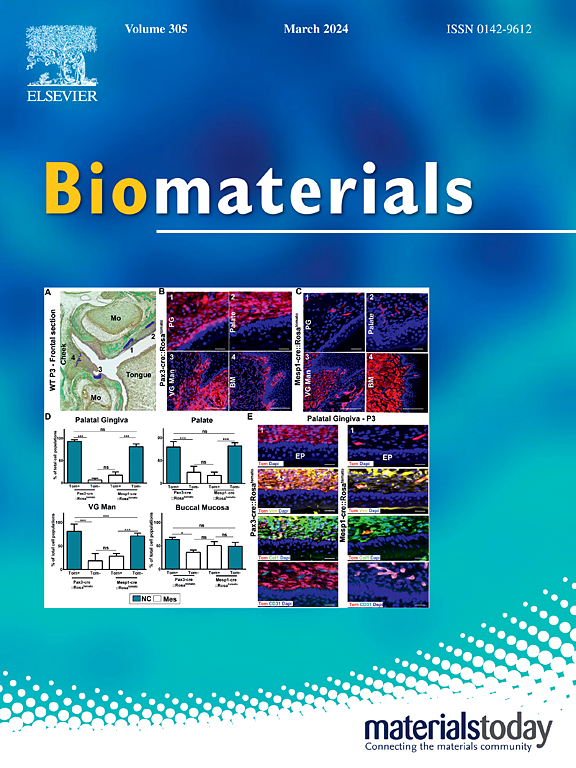Synergistic microglial modulation by laminarin-based platinum nanozymes for potential intracerebral hemorrhage therapy
IF 12.9
1区 医学
Q1 ENGINEERING, BIOMEDICAL
引用次数: 0
Abstract
Abnormal microglial activation increases inflammation, causing significant brain damage after intracerebral hemorrhage (ICH). To aid recovery, treatments should regulate oxidative stress and inhibit the M1-like phenotype (pro-inflammation) of microglia. Recently, antioxidant nanozymes have emerged as tools for modulating microglial states, but detailed studies on their role in ICH treatment are limited. To address this, we developed an ultra-small (3–4 nm) laminarin-modified platinum nanozyme (Pt@LA) for the synergistic regulation of microglial polarization, offering a novel therapeutic strategy for ICH. Pt@LA effectively scavenges reactive oxygen species (ROS) through superoxide dismutase (SOD) and catalase (CAT)-like activities. Laminarin may inhibit the Dectin-1 receptor on microglia and its inflammatory pathway, Syk/NF-κB, reducing neuroinflammation. In vitro, Pt@LA decreased pro-inflammatory microglia and cytokine expression by inhibiting the Dectin-1/Syk/NF-κB and ROS-mediated NF-κB pathways. Furthermore, Pt@LA protected neurons, inhibited glial scar formation, and improved neurological function in ICH rats. Overall, this study presents Pt nanozymes based on naturally extracted laminarin and explores their application in alleviating oxidative stress and neuroinflammation after ICH, bridging nanozyme research and neuroscience.

基于层粘连素的铂纳米酶对小胶质细胞的协同调节可用于潜在的脑出血治疗
异常的小胶质细胞激活增加炎症,导致脑出血(ICH)后显著的脑损伤。为了帮助恢复,治疗应该调节氧化应激和抑制小胶质细胞的m1样表型(促炎症)。最近,抗氧化纳米酶已成为调节小胶质细胞状态的工具,但对其在脑出血治疗中的作用的详细研究有限。为了解决这个问题,我们开发了一种超小(3-4 nm)层蛋白修饰的铂纳米酶(Pt@LA),用于协同调节小胶质细胞极化,为脑出血提供了一种新的治疗策略。Pt@LA通过超氧化物歧化酶(SOD)和过氧化氢酶(CAT)样活性有效清除活性氧(ROS)。层粘胶蛋白可能抑制小胶质细胞上的Dectin-1受体及其炎症通路Syk/NF-κB,减轻神经炎症。Pt@LA通过抑制Dectin-1/Syk/NF-κB和ros介导的NF-κB通路,降低促炎小胶质细胞和细胞因子的表达。此外,Pt@LA保护神经元,抑制神经胶质瘢痕形成,改善脑出血大鼠的神经功能。综上所述,本研究提出了基于天然提取层粘胶蛋白的Pt纳米酶,并探讨了其在缓解脑出血后氧化应激和神经炎症方面的应用,将纳米酶研究与神经科学联系起来。
本文章由计算机程序翻译,如有差异,请以英文原文为准。
求助全文
约1分钟内获得全文
求助全文
来源期刊

Biomaterials
工程技术-材料科学:生物材料
CiteScore
26.00
自引率
2.90%
发文量
565
审稿时长
46 days
期刊介绍:
Biomaterials is an international journal covering the science and clinical application of biomaterials. A biomaterial is now defined as a substance that has been engineered to take a form which, alone or as part of a complex system, is used to direct, by control of interactions with components of living systems, the course of any therapeutic or diagnostic procedure. It is the aim of the journal to provide a peer-reviewed forum for the publication of original papers and authoritative review and opinion papers dealing with the most important issues facing the use of biomaterials in clinical practice. The scope of the journal covers the wide range of physical, biological and chemical sciences that underpin the design of biomaterials and the clinical disciplines in which they are used. These sciences include polymer synthesis and characterization, drug and gene vector design, the biology of the host response, immunology and toxicology and self assembly at the nanoscale. Clinical applications include the therapies of medical technology and regenerative medicine in all clinical disciplines, and diagnostic systems that reply on innovative contrast and sensing agents. The journal is relevant to areas such as cancer diagnosis and therapy, implantable devices, drug delivery systems, gene vectors, bionanotechnology and tissue engineering.
 求助内容:
求助内容: 应助结果提醒方式:
应助结果提醒方式:


